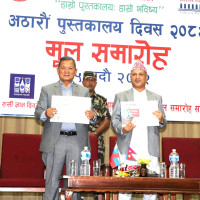- Sunday, 31 August 2025
Loud Music In Buses
Public buses in Nepal are characterised by loud music from old speakers and the honking of two and four-wheelers. Whether it’s folk, local pop, Bollywood, or even English music, hits are played in these buses, no matter whether the commuters love to listen to them. Why do people, especially drivers, love blasting these speakers?
To some, instrumentation in buses adds an aesthetic element to the ride. Suman Thapa, a local bus driver operating on the Ratnapark-Kritipur-Bhakepati route, says, "It keeps the journey enjoyable, especially when there is a heavy traffic jam. Passengers also seem to love it—many even request some tunes," he added. His statement highlights how deeply established music is in the everyday rhythm of Nepal’s public transport. For many drivers like Suman, it is not just about entertainment—it is about habit, mood management, and a source of daily motivation to work.
This practice of playing loud music has become a daily routine in most city buses. It has blended into the driving culture in such a way that a ride without music may feel incomplete to many drivers and even to some passengers. From early morning to late evening, the music continues nonstop, echoing through the narrow streets of cities like Kathmandu, Pokhara, Biratnagar and Janakpur. The trend isn’t confined to any specific region, and it spans across the country—from the plains of the Tarai to the hilly roads of Nepal. It’s often regarded as a symbol of brightness, energy, and even youthfulness.
Passengers, however, have divided opinions. While some enjoy the entertainment during their travel, others, particularly students and professionals, find it stressful and distracting. Students like Bivek Raj Rajbanshi have expressed contempt towards this practice. For students who take classes and travel regularly, listening to music while commuting should not be done in public buses. He calls it distracting. His opinion is shared by many commuters who seek a quiet or neutral space during their travel, especially after long days at school, college or work.
For long hours like those experienced by passengers within a vehicle alongside other individuals emitting high decibel levels, such as blaring instruments, it can potentially cause permanent hearing loss or lack of concentration. Mental fatigue, irritation, and even motion sickness have also been reported by some passengers who are exposed to continuous loud music during their daily commute. In some extreme cases, frequent exposure to such sound environment can also trigger anxiety, particularly in individuals sensitive to noise.
Loud music in buses is not illegal by law but is discouraged due to its growing interference with traffic safety. "We understand music is part of the travel experience, especially in Nepal’s public transport culture. But when it crosses volume limits, it becomes a threat," a traffic police officer stationed at Koteshwar told this scribe. The police department has reportedly been conducting periodic awareness campaigns, reminding public vehicle operators to keep music at a reasonable level. As of now, there is no specific regulation setting a decibel limit for music in buses, but authorities are reportedly considering drafting such guidelines in collaboration with the Department of Transport. These guidelines, once enacted, could help standardise sound levels and ensure a more peaceful travel environment for all types of commuters.
Experts from health and traffic sectors have also recommended that public transport vehicles should prioritise safety and comfort for all passengers. Alternative solutions like playing soft background music, using headphones for passengers or even installing noise-level monitors have been proposed, although implementation remains limited.
















